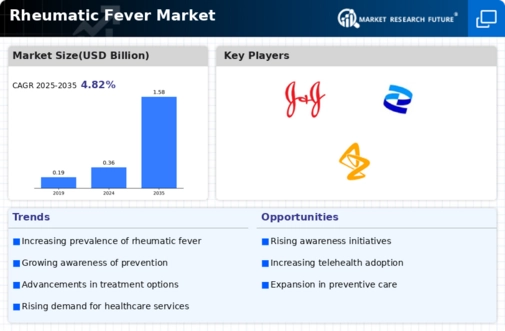Market Trends
Key Emerging Trends in the Rheumatic Fever Market
The market dynamics of rheumatic fever have changed significantly due to developments in diagnostic techniques, treatment methods, and the awareness about this inflammatory disease. Rheumatic fever is a serious consequence of untreated streptococcus infections of the throat that increasingly has been identified promptly. Diagnostic accuracy and speed in rheumatic fever which allow for timely management and prevention of complications have been improved by employing molecular biology and serology tests among other diagnostic tools.
Rf therapeutic landscape witnessed a shift towards patient-centered care. The recurrent nature of rheumatic fever could be avoided by prescribing antibiotics targeting the underlying streptococcal infection. In the same vein, nonsteroidal anti-inflammatory drugs (NSAIDs) as well as corticosteroids help reduce discomfort and inflammation characteristic of this condition. A multi-disciplinary approach seems to be emerging as a trend in treating RF that takes into account not only acute period but also long-term consequences such as rheumatic heart disease.
One significant market trend is towards prevention measures aimed at stopping streptococcal infections from advancing to rheumatic fever. Early detection and prompt treatment of Streptococcus pyogenes throats are being made possible through public health initiatives, campaigning, and increased knowledge among healthcare providers, even leading to a reduction in the incidence rate of RF. There are also proposals for vaccination against certain strains of streptococcus, all geared towards preventive approach in handling the root causes for this illness.
Global partnerships between groups have become more pronounced within the RF market. This involves governments’ efforts to share resources among other stakeholders like pharmaceuticals companies or non-governmental organizations for research purposes. Such interactives are aimed at addressing broader challenges surrounding RF thus enabling new therapies, diagnostics or preventative strategies.
Technological advancements especially those related to telemedicine and digital health are shaping how rheumatic fever is treated today. Telemedicine enables virtual consultations with doctors remotely thereby overcoming geographical boundaries while guaranteeing access to healthcare services. This has become even more significant amid the Covid-19 pandemic where telehealth solutions have been critical in ensuring continued care for rheumatic fever patients and other related conditions.
The growing importance of patient advocacy and support networks is another noticeable trend within the RF market. These groups play an active role in raising awareness, helping patients as well as their families and lobbying for policy changes that would improve accessibility to treatment. Such a collaborative effort seeks to empower those with RF condition, fight against stigma associated with it, and make communities better understand the ailment.
Regulatory considerations are important in the rheumatic fever market since they allow regulatory agencies to streamline regulatory approval processes for relevant therapies or interventions. This collaboration between regulators, medical professionals and stakeholders of industry is needed so that safe and effective therapies can be made available to people with Rf disease.






Leave a Comment